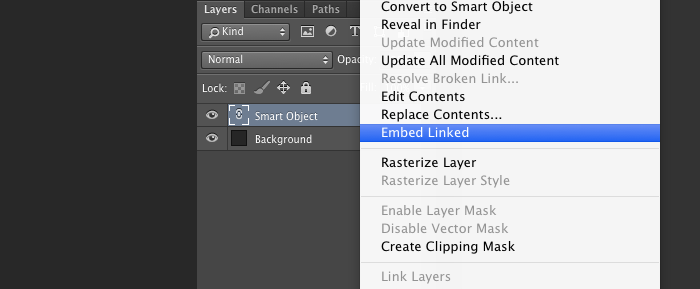Revolutionizing Creativity: A Deep Dive into Photoshop CC 2014’s Smart Objects

In the ever-evolving landscape of digital design, Adobe Photoshop stands as a beacon of innovation. Each iteration of this powerful software brings forth new features that not only streamline workflows but also redefine the boundaries of creative expression. Among the game-changing features introduced in Photoshop CC 2014, none have garnered as much attention and acclaim as the transformative Smart Objects.
Understanding the Essence of Smart Objects
The Birth of Smart Objects:
Smart Objects were not entirely novel to Photoshop CC 2014, but this version marked a significant enhancement, solidifying their role as indispensable tools for designers and photographers. The concept of Smart Objects emerged as a response to the need for non-destructive editing, allowing users to retain the original quality of an image or graphic while applying various adjustments.
Non-Destructive Editing Unleashed:
At its core, Smart Objects revolutionize the editing process by preserving the source content. When a layer is converted into a Smart Object, it acts as a container that encapsulates the original data. Unlike traditional raster layers, Smart Objects allow for non-destructive transformations, filters, and adjustments, ensuring that the underlying image or graphic remains unaltered.
The Power of Smart Objects
Endless Transformations:
One of the key advantages of Smart Objects is their ability to undergo transformations without sacrificing image quality. Whether scaling, rotating, or skewing, Smart Objects maintain the integrity of the original content. This is particularly crucial for projects that demand scalability and flexibility, such as web design, where images may be displayed across various screen sizes.
Filter Freedom:
Smart Objects liberate designers from the constraints of irreversible filters. By converting a layer to a Smart Object before applying filters, users can later modify or remove the filter without degrading the image quality. This newfound flexibility empowers designers to experiment with different effects, knowing that they can fine-tune or readjust at any stage of the creative process.
Embedded Data and Linked Files:
Photoshop CC 2014 took the capabilities of Smart Objects a step further by introducing the option to embed external files or link to them. This feature is particularly advantageous when collaborating on projects that involve dynamic content, such as data visualizations or charts. Embedded data or linked files ensure that the Smart Object always reflects the latest information.
Smart Filters for Smart Workflows:
Smart Filters, an inherent aspect of Smart Objects, provide an intelligent approach to filter application. Rather than directly applying a filter to a layer, users can apply it to a Smart Object, turning it into a Smart Filter. This allows for real-time adjustments, reordering of filters, and even masking specific areas, resulting in a more refined and nuanced application of filters.
Integrating Smart Objects into Workflows
Efficiency in Design Mockups:
For designers engaged in creating intricate mockups, Smart Objects offer a time-saving and efficient solution. By incorporating vector graphics or high-resolution images as Smart Objects, designers can swiftly update the content while preserving the overall layout. This is especially advantageous when presenting design iterations to clients or stakeholders.
Photographic Precision:
Photographers, too, benefit significantly from the capabilities of Smart Objects. When working with high-resolution images, the ability to make extensive edits without compromising quality is paramount. Smart Objects serve as a safeguard against unintentional degradation, allowing photographers to experiment with various adjustments while maintaining the original pixel data.
Streamlining Collaborative Work:
In collaborative environments, Smart Objects facilitate smoother workflows. By embedding or linking external files, collaborators can ensure that the most up-to-date information is reflected in the project. This proves invaluable in scenarios where multiple contributors are involved, each responsible for a specific aspect of the design that may evolve over time.
Overcoming Challenges and Exploring Advanced Features
Balancing File Size and Performance:
While the advantages of Smart Objects are abundant, it’s essential to strike a balance between functionality and file size. Large numbers of Smart Objects, especially those containing complex vector data, can contribute to larger file sizes. Designers and artists must be mindful of this aspect, particularly when working on projects with stringent file size constraints.
Advanced Features for Power Users:
Photoshop CC 2014 caters to power users by introducing advanced features within the Smart Objects framework. Linked Smart Objects allow for shared content across multiple documents, ensuring consistency in projects with recurring elements. Additionally, the ability to convert layers into Smart Objects via the new “Convert to Linked” option further enhances efficiency in managing complex compositions.
Conclusion: A Paradigm Shift in Design
Photoshop CC 2014’s elevation of Smart Objects from a useful tool to a cornerstone of design workflows represents a paradigm shift in the way creatives approach image editing and manipulation. The non-destructive nature of Smart Objects, coupled with their versatility and collaborative features, makes them an indispensable asset for professionals across diverse creative disciplines.
As designers continue to push the boundaries of visual expression, Smart Objects stand as a testament to Adobe’s commitment to empowering creatives with tools that not only meet but anticipate their evolving needs. Whether crafting stunning visuals for digital platforms, refining photographic masterpieces, or streamlining collaborative design processes, Smart Objects in Photoshop CC 2014 have left an indelible mark on the landscape of digital design, revolutionizing creativity in the process.







